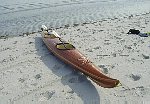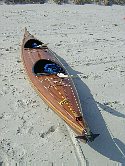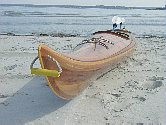
Cape Ann Double
Technical specs...
 |
Cape Ann Double Technical specs... |
Fast,
seaworthy tandem cruiser for touring and expeditions.  
Cape Ann Double description | MATERIALS |

|
 |
 |
 |
 |
| Property | English | Units | Metric | Units | Comments |
|---|---|---|---|---|---|
| Length Overall | 21 | ft | 6,4 | m | length from bow to stern as designed |
| Beam Overall | 27 | in | 68,5 | cm | widest part of kayak |
| Draft | 4.5 | in | 11,4 | cm | baseline to Designed Water Line (DWL) |
| Volumetric Properties | |||||
| Displacement | 433.3 | lb | 196,9 | kg | at DWL |
| Volume | 6.77 | ft^3 | 191,6 | liters | displacement in cubic feet or liters of sea water |
| Wetted Surface | 30.89 | ft^2 | 2,86 | m^2 | underwater surface area to DWL |
| LCB | 9.83 | ft | 2,99 | m | longitudinal center of buoyancy from x=0 |
| LCB % LWL | % | 51,7 | % | LCB as a percetage of waterline length from x=0 | |
| VCB | 2.73 | in | 6,97 | cm | vertical center of buoyancy from baseline |
| Waterplane Properties | |||||
| Waterplane area | 26.3 | ft^2 | 2,44 | m^2 | at DWL |
| LCF | 9.81 | ft | 2,99 | m | longitudinal center of flotation from x=0 |
| LCF % LWL | % | 51,6 | % | LCF as a percetage of waterline length from x=0 | |
| LWL | 19 | ft | 5,78 | m | length of waterline; same as DWL |
| BWL | 25.5 | in | 65,1 | cm | beam of waterline |
| Sinkage | 140.6 | lb/in | 25,17 | kg/cm | pounds displaced per one inch of sinkage |
| Form Coefficients (no units, same for metric) | |||||
| Cb | 0.448 | block | |||
| Cm | 0.824 | midship | |||
| Cp | 0.544 | prismatic | |||
| Cwp | 0.649 | waterplane | |||
| Area/Displacement | 8.63 | Area / Displacement ratio [ft^2/(ft^3)^2/3] | |||
| Length / Beam | 8.88 | Length / Beam ratio [LWL / BWL] | |||
| Miscellaneous | |||||
| Area of cockpit | 3.33 | ft^2 | 0,309 | m^2 | for cockpit template in plans (small) |
| Circumference | 7 | ft | 2,13 | m | cockpit |
| Depth in front | 14.25 | in | 36,1 | cm | front cockpit |
| Depth in rear | 12.75 | in | 32,3 | cm | front cockpit |
| Depth in front | 12.5 | in | 31,7 | cm | rear cockpit |
| Depth in rear | 11.75 | in | 29,8 | cm | rear cockpit |
| Cockpit spacing | 6.0 | in | 1,82 | cm | center to center |
| Deck area | 36.4 | ft^2 | 3,38 | m^2 | includes cockpit area |
| Hull area | 44.2 | ft^2 | 4,1 | m^2 | |
| Loading | Medium to large paddlers, // Recommended max. load - 520lb | ||||
| x=0 the start of waterline (DWL) at bow | |||||
| . |
Material |
||||||||||||||||||||||||
| Wood strips - assumes bead & cove strips | |||||||||||||||||||||||||
| Unit
converter |
Notes & Tips:
|
||||||||||||||||||||||||
| Fiberglass coverage | |||||||||||||||||||||||||
Notes & Tips:
|
|||||||||||||||||||||||||
| Epoxy | |||||||||||||||||||||||||
| Minimum
total volume of epoxy mix (resin + hardener): 3 to 4 gallons Notes & Tips:
|
Back to Kayak
Designs | Plans | Kayak
comparison page
| Home | Kayak Designs | Kayak Shop | Materials | Kayak Gallery | About us |
| Building Manual | Plans | Sandwich Core | Wood Kayak | Order | |
| Epoxy Test | Abrasion Cloth | Rudder | Resources | Choosing Kayak | Guestbook |
If you notice any problems with the site (i.e. error links, missing images) please, let me know. Thanks
Mail:
Vaclav Stejskal
58 Wood Ln.
Acton, MA 01720
USA
Tel: 781-481-9261
© 1999
- 2024 Copyright Vaclav Stejskal
All rights reserved
Last page update:
9 May 2024